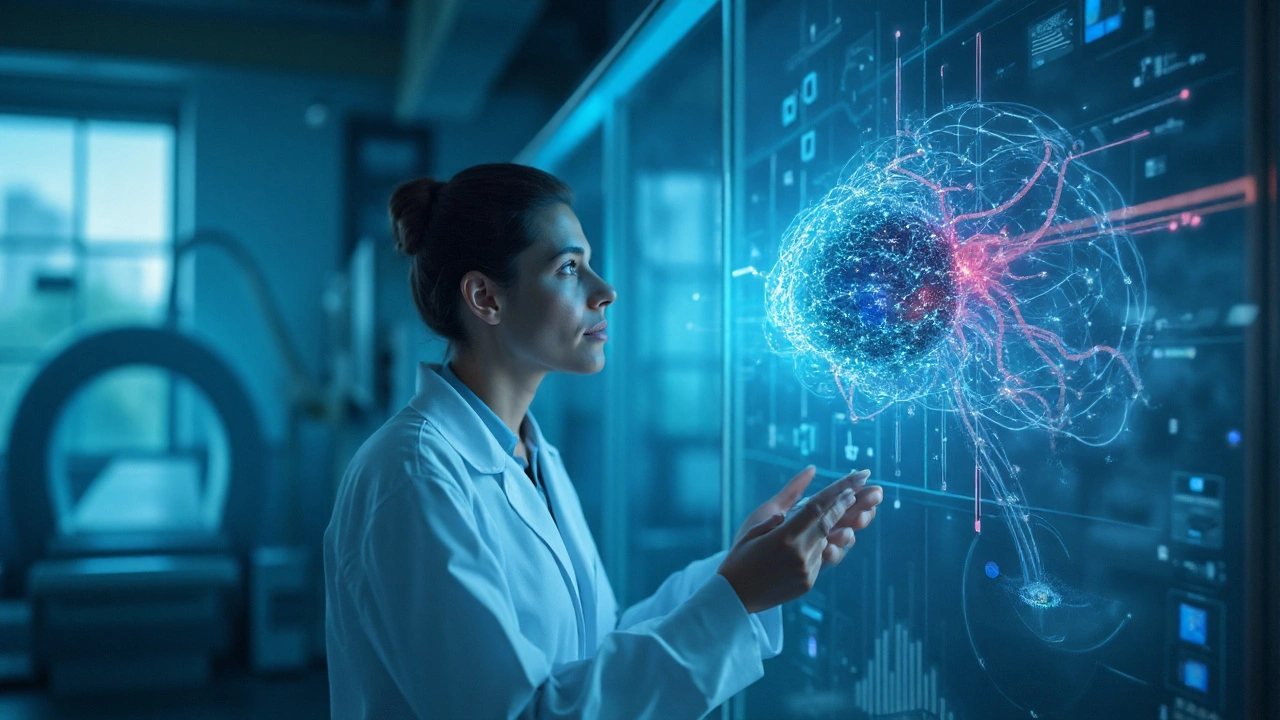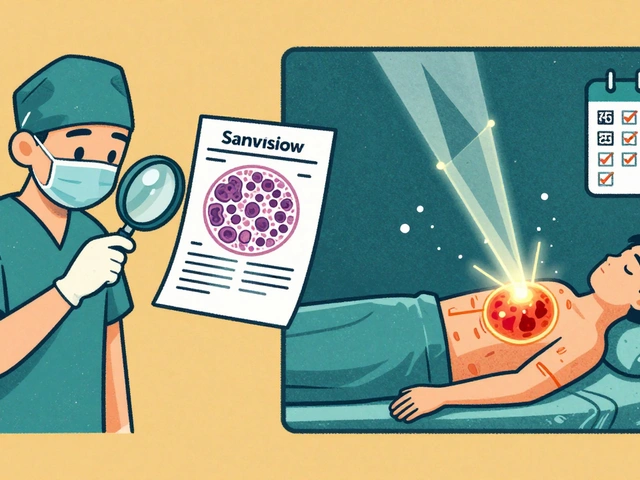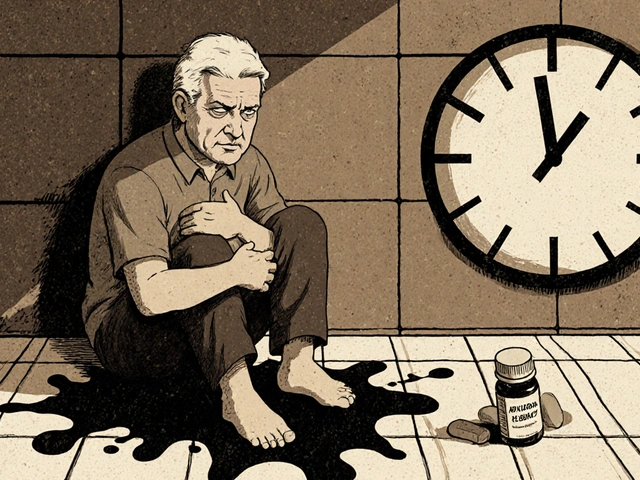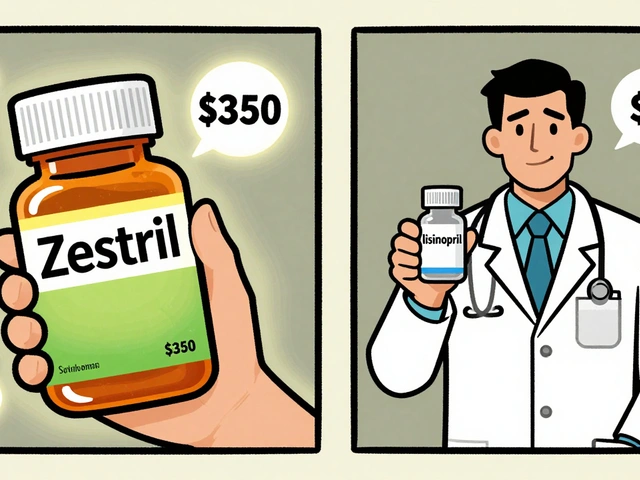Future OCD Research & Treatment: Emerging Therapies & Technologies
Obsessive‑Compulsive Disorder (OCD) is a neuropsychiatric condition characterised by intrusive thoughts and compulsive behaviours that cause significant distress and functional impairment. Today, about 2% of adults worldwide live with OCD, yet only half receive evidence‑based care.
TL;DR
- Neurocircuitry mapping and genetics are pinpointing biomarkers for personalised care.
- Deep brain stimulation (DBS) and transcranial magnetic stimulation (TMS) are moving from experimental to clinical use.
- Glutamate‑targeting drugs and rapid‑acting agents promise faster symptom relief.
- Digital therapeutics and AI‑driven diagnostics are expanding access to exposure‑based therapy.
- Future guidelines will blend neuromodulation, pharmacology and tech‑enabled psychotherapy.
Where We Stand: The Current Treatment Landscape
First‑line care still hinges on Cognitive‑Behavioural Therapy (CBT) is a structured psychotherapy that helps patients identify and challenge maladaptive thoughts, with its exposure‑focused arm, Exposure and Response Prevention (ERP) is a behavioural technique that repeatedly exposes patients to feared stimuli while preventing compulsive rituals. Pharmacologically, Selective Serotonin Reuptake Inhibitors (SSRIs) are a class of antidepressants that increase serotonin levels and reduce obsessive thoughts in many patients. Together, CBT/ERP and SSRIs lift symptoms for roughly 60% of patients, but a sizable minority remains refractory.
Neurocircuitry & Biomarker Breakthroughs
Advanced functional MRI and diffusion tensor imaging are mapping the cortico‑striato‑thalamo‑cortical (CSTC) loop that underpins compulsive behaviour. Recent genome‑wide association studies (GWAS) point to variants in the SLC1A1 gene, linking glutamate transport to symptom severity. These findings are giving rise to OCD biomarkers are a set of measurable biological signals-genetic, neuroimaging or proteomic-that predict treatment response. Early‑stage trials use biomarkers to stratify participants, cutting trial failure rates by up to 30%.
Neuromodulation: From Invasive to Non‑Invasive
Two modalities dominate the horizon:
- Deep Brain Stimulation (DBS) is a surgical technique that delivers chronic electrical pulses to specific brain nuclei, typically the ventral capsule/ventral striatum for OCD. Recent multicentre studies report a 57% reduction in Yale‑Brown Obsessive‑Compulsive Scale (Y‑BOCS) scores after 12months, with adverse events dropping thanks to refined lead placement.
- Transcranial Magnetic Stimulation (TMS) is a non‑invasive method that uses magnetic fields to modulate cortical excitability, often targeting the dorsomedial prefrontal cortex in OCD. Accelerated protocols (10sessions per day for 5days) are shrinking treatment timelines from weeks to days, achieving remission rates comparable to conventional ERP.
| Therapy | Mechanism | Invasiveness | Evidence Phase | Typical Cost (USD) |
|---|---|---|---|---|
| Deep Brain Stimulation | Chronic electrical stimulation of CSTC loop | Surgical implantation | PhaseIII | ≈150,000 (procedure + device) |
| Transcranial Magnetic Stimulation | Repeated magnetic pulses to dorsomedial PFC | Non‑invasive | PhaseII‑III | ≈5,000‑10,000 (full course) |
| Glutamate Modulator (e.g., D‑Cycloserine) | Enhances NMDA‑mediated learning during ERP | Oral medication | PhaseII | ≈200 (12‑week course) |
| Digital Therapeutic (OCD Coach App) | AI‑guided exposure exercises with real‑time feedback | Non‑invasive | PhaseII | ≈150 (annual subscription) |
Pharmacological Frontiers Beyond SSRIs
Researchers are targeting the glutamatergic system to accelerate symptom reduction. Glutamate modulators are a class of agents that fine‑tune excitatory neurotransmission, including D‑cycloserine, riluzole and memantine. Early trials show that adding D‑cycloserine to ERP boosts learning curves, shaving days off the typical 12‑week ERP timeline. Simultaneously, rapid‑acting compounds like ketamine derivatives are entering PhaseII, aiming for immediate relief of intrusive thoughts-an approach borrowed from depression research.

Digital Therapeutics, AI, and Remote Care
Mobile platforms now deliver graded exposure exercises, track compulsive urges, and provide psycho‑educational modules. A notable example, the OCD Coach App is a digital therapeutic that combines AI‑driven cue detection with therapist‑in‑the‑loop video sessions. In a pragmatic RCT, users of the app alongside standard ERP achieved a 12‑point greater reduction on the Y‑BOCS than ERP alone. Machine‑learning algorithms are also being trained on speech and typing patterns to flag relapse risk weeks before patients notice it themselves.
Personalised & Precision Medicine: The Next Step
Integrating biomarkers, genetics, and real‑world digital data paves the way for treatment algorithms that recommend the optimal mix of CBT, neuromodulation and medication. Pharmacogenomic testing can identify patients who metabolise SSRIs poorly, steering clinicians toward serotonin‑norepinephrine reuptake inhibitors (SNRIs) or glutamate‑focused agents. In the coming decade, clinical decision‑support tools-validated by NHS England and the FDA-will likely embed these algorithms directly into electronic health records.
Practical Roadmap for Clinicians and Patients
- Screen for comorbidities and baseline biomarker panel (genetic + neuroimaging where available).
- Start evidence‑based CBT/ERP; augment with a low‑dose SSRI unless contraindicated.
- If Y‑BOCS remains >24 after 12weeks, consider adding a future OCD treatment such as DBS (for severe refractory cases) or TMS (for moderate‑to‑severe cases).
- Introduce a glutamate modulator or rapid‑acting agent to speed ERP learning, monitoring for side‑effects.
- Enroll patients in digital therapeutic programs for continual exposure practice and AI‑based relapse monitoring.
- Re‑assess quarterly using biomarker trends to refine the therapeutic mix.
This stepped approach harnesses the best of today’s science while staying nimble enough to adopt breakthroughs as they prove safe and effective.
Related Concepts and Emerging Topics
Understanding OCD’s future also means keeping an eye on adjacent research areas: the gut‑brain axis and microbiome interventions, CRISPR‑based gene editing for high‑risk families, and virtual‑reality exposure platforms that simulate feared scenarios with unprecedented realism. While these are still in pilot phases, they illustrate the expanding ecosystem feeding into the core treatment paradigm.
Frequently Asked Questions
What is the difference between DBS and TMS for OCD?
DBS involves surgical implantation of electrodes and delivers continuous stimulation, making it suitable for severe, treatment‑resistant OCD. TMS is non‑invasive, uses magnetic pulses over specific cortical areas, and is usually offered when patients are not candidates for surgery or need a less intensive option.
Are glutamate modulators ready for routine use?
They are not yet first‑line, but several PhaseII trials show they can boost ERP outcomes. Clinicians may consider them as adjuncts in patients who plateau on SSRIs and CBT.
How effective are digital therapeutics compared to face‑to‑face therapy?
In controlled studies, digital platforms combined with therapist support achieve similar Y‑BOCS reductions as traditional ERP, while offering greater accessibility and continuity between sessions.
Can biomarkers predict which patients will respond to DBS?
Early data suggest that hyperactivity in the ventral striatum on functional MRI correlates with better DBS outcomes, but larger validation cohorts are needed before routine clinical use.
What safety concerns exist for TMS in OCD?
TMS is generally well‑tolerated; the most common side‑effects are mild scalp discomfort and temporary headaches. Rarely, it can trigger seizures, so screening for epilepsy risk is essential.
How soon might CRISPR technology affect OCD treatment?
CRISPR is still in pre‑clinical stages for psychiatric disorders. Ethical, regulatory, and delivery challenges mean mainstream use is at least a decade away, but research is advancing rapidly.





12 Comments
Naomi Shimberg
September 22 2025The recent surge of enthusiasm surrounding emerging OCD interventions warrants a measured appraisal.
While the allure of deep brain stimulation and AI-driven therapeutics is undeniable, one must not conflate novelty with efficacy.
The extant literature, albeit promising, frequently suffers from small sample sizes and heterogeneous outcome measures.
Furthermore, the financial outlay associated with neuromodulation exceeds what many health systems can sustainably support.
A reliance on biomarkers, though intellectually seductive, presently lacks the replication needed for clinical deployment.
It would be imprudent to champion glutamate modulators as panaceas before rigorous Phase III data emerge.
Equally, the purported rapid‑acting effects of ketamine derivatives remain constrained by concerns of neurotoxicity and abuse potential.
Digital therapeutics, while expanding access, cannot supplant the therapeutic alliance fostered by skilled clinicians.
In addition, the regulatory landscape for AI‑based diagnostics is still nascent, raising questions about accountability.
Consequently, a paradigm that privileges incremental improvement of established CBT/ERP protocols may prove more judicious.
Patients should be counseled about realistic expectations rather than enticed by hype.
Clinicians must retain a vigilant stance, critically evaluating each emerging modality on its own merit.
The integration of novel technologies should proceed within the confines of controlled, multi‑center trials.
Only through such disciplined inquiry can we ensure that progress translates into genuine, durable relief.
Until then, optimism must be tempered by rigorous scrutiny.
kenny lastimosa
September 27 2025I'm inclined to consider the ethical dimensions of accelerating neuromodulation without sufficient longitudinal data.
The philosophical underpinnings of patient autonomy demand that we preserve informed consent as a cornerstone.
Yet, the lure of immediate symptom relief can obscure these considerations.
It seems prudent to balance hope with humility.
In any case, the discourse should remain open‑ended.
Heather ehlschide
October 2 2025Current guidelines suggest initiating CBT/ERP alongside a low‑dose SSRI, reserving neuromodulation for refractory cases.
Biomarker panels, when available, can aid stratification, but they are not yet standard of care.
For clinicians, maintaining a stepped‑care algorithm helps allocate resources efficiently.
Kajal Gupta
October 8 2025Wow, love the straight‑to‑the‑point vibe! 😊 The way you break down the stepped‑care plan is like a recipe-just add a dash of CBT, sprinkle some SSRIs, and if you still taste the bitterness, toss in a pinch of TMS.
The biomarkers are the new garnish, but we gotta remember they’re still experimental spice.
Keep the sauce simmering, and we’ll all feast on better outcomes!
Zachary Blackwell
October 13 2025People don’t tell you that the big pharma giants are quietly funneling millions into DBS research to create a new revenue stream, and they disguise it as ‘patient‑centered innovation.’ Meanwhile, the AI companies are mining our therapy data to sell back to insurers, turning mental health into a data commodity.
It’s all a slick PR dance, but the bottom line stays the same: profit over truly caring care.
prithi mallick
October 18 2025I hear you and it does make you think about the deeper layers of control.
We cant ignore the fact that every new tech brings both hope and fear, its like walkin on a tightrope of progress.
Perhaps we should stay open minded but also hold the line when the evidence isnt solid yet.
Keep questionin the narrative, and we might find a more balanced path.
Michaela Dixon
October 24 2025I've been watching the evolution of OCD treatments for years and I find it fascinating how each new wave seems to promise a miracle yet often delivers only incremental change but the excitement in the community keeps building as researchers publish early results from glutamate modulators and digital platforms and the conversation turns into a whirlwind of hopeful headlines and cautious optimism and while I appreciate the enthusiasm I also worry that patients may get caught up in the hype and miss out on the proven benefits of consistent exposure therapy and the therapeutic alliance that can't be replicated by an app or a magnetic coil it feels like we're balancing on a tightrope between innovation and tradition and that balance is delicate yet crucial for lasting improvement
Dan Danuts
October 29 2025Absolutely! Your take really hits the nail on the head – keep pushing forward, stay curious, and remember that every small step in research can light up a whole new path for patients!
Dante Russello
November 3 2025Indeed, the integration of neuromodulation, pharmacology, and digital therapeutics represents a multifaceted approach; however, each component must be evaluated rigorously, with clear endpoints, and transparent reporting; only then can we ascertain true efficacy, safety, and cost‑effectiveness for diverse patient populations.
James Gray
November 9 2025Totally agree, this is defintely the way forward!
Scott Ring
November 14 2025Thanks for laying it out clearly, I think a lot of clinicians will find this roadmap useful.
Shubhi Sahni
November 19 2025Indeed, your summary captures the essence of current advances; it is both comprehensive and accessible; well done!